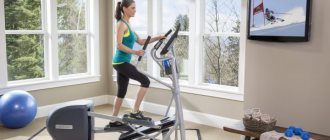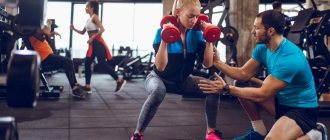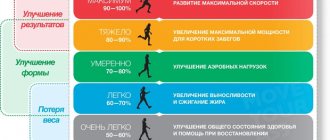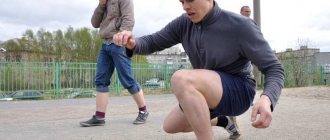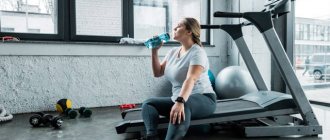It is quite difficult for a working person to find time for a morning run, and getting up a few hours earlier in order to have time to warm up, go for a run and get ready for work is even more difficult. Only a few are able to perform such feats regularly.
Why do some people prefer to run at night?
And in the evening after work or study, you can calmly go for a run and at the same time get rid of the negative emotions accumulated during the day. But many people wonder whether they will be able to fall asleep after such prolonged physical activity.
Olga Begasheva
somnologist
Talks about the pros and cons of jogging before bed.
Who is suitable for evening running?
The human body is best prepared for physical activity from about 17:00 and works in this way until 20:00-21:00. This is due to the fact that in the first half of the day our brain and internal organs are busy restoring energy after a night's sleep.
By evening, the cardiovascular and respiratory systems are already comfortable working. The muscles reach the peak of their own tone, and the tendons and ligaments are maximally warmed up, because during the day we move and load our legs. Evening jogging is most suitable for people training endurance, speed and leg muscle strength.
Photo: istockphoto.com
If you experience fatigue, slowness and a desire to lie down after morning workouts or jogging, you have low dopamine levels and inversion of circadian rhythms. This means that in the morning it is better for you not to burden your body. Lethargy after a morning workout appears because you do not have a clear routine, and by the morning there is no release of cortisol, thanks to which we are active in the early hours.
Warm-up exercises before running
There are two options for warming up: in place and in motion. Usually these options follow one after another, and first there is a warm-up in motion, and then a set of general developmental exercises in place. In the case of warming up for running, the reverse order is possible: perform the complex on the spot, and then in motion.
A set of exercises for warming up on the spot
A typical on-site warm-up routine includes 8-12 exercises with an average of 6-8 repetitions. The exercises are performed at an average pace, without jerking.
- Head rotation. Count 1-4 to the right, 5-8 to the left. Repeat 6-8 times.
- Hands to shoulders. Perform rotations with a change of direction (4 counts forward, the same backwards).
- Jerks with arms while turning the body to the right, left – 6 times.
- Circular rotations of the pelvis changing direction to the right, left 8 times on each side.
- Bend alternately towards the right, center and left leg. After touching your left leg, take the starting position - hands on your belt.
- Circular rotations of the hip joint, 16 repetitions on each leg. Crunching while performing the exercise does not cause harm.
- Alternately pulling the thigh toward the body by grabbing the knee with both hands.
- Deep lunges forward. Try to feel the stretch in the back of your thigh.
- Side lunges. You can perform rolls using your hands.
- Ankle rotations, 32 repetitions on each leg.
Set of exercises for warming up
The complex contains standard exercises for the upper part and special exercises for warming up the legs.
A set of exercises for warming up in motion
Complexes in motion are otherwise called special running exercises. This set is in many ways similar to the introduction exercises that are used to learn the basics of sprinting and staying.
- Running with a high hip lift. Try to perform as often as possible with minimal advancement at a distance of 15-20 meters.
- Wheel. Performed similarly to the first exercise, but with the toe thrown up. This results in a longer hip extension. You can see the correct exercise technique on the page dedicated to fast running.
- Running with shin choking. The arms work as if they were running. Do it quickly and with little progress.
- Running with straight legs forward. Hands work as in the second exercise. Extend your leg as high as possible. Do not lean your body back.
- Running with your back. Look over your right and left shoulders if there are people practicing nearby.
- Cross step with right and left sides. Try not to turn your body; only your legs should be involved in the work.
- Lunges for every step. The back is straight, the position of the hands is free (lowered, on the belt or behind the head).
- Multi-jump or deer run. Perform jumps with alternating push-offs with one leg.
On average, warming up before running takes about 10-15 minutes. It is worth remembering that during the warm-up the training has already begun. The load during warm-up reaches up to 30% of the total load during the workout.
What are the benefits of evening running?
Running at dawn is great, but there are also plenty of benefits to running in the evening.
- It will be easier for you to bear the load. Strength and endurance increase at the end of the day. In the evening, your body makes better use of the oxygen that goes to your muscles, which means you can cover longer distances.
- You will be more relaxed. If you are under stress throughout the day, then all body systems work at double capacity. And evening jogging will help you regain strength, no matter how paradoxical it may sound, relax and be more resistant to stress in the future. And endorphins, which are produced during physical activity and provide a good mood, help with this.
5 common injuries in new runners
- Evening is a time to be alone with your thoughts. People rest more often at night and do not think about daily responsibilities. This not only improves their mood, but also helps them get rid of external distractions to think about their own goals and desires.
- You will become more conscious of your health. After a run, it is difficult to eat carbohydrate-rich foods. On the contrary, the body is looking for something easier to recover, mainly protein foods. Running at the end of the day will help you make better choices and avoid overeating at night.
Olga Begasheva
somnologist
Evening jogging is good for those who are experiencing a period of seasonal depression: their ability to work is decreasing, bad weather is pressing, and the nights have become longer. In the evening after a run, they will produce norepinephrine, adrenaline, dopamine and all types of catecholamines. These substances will help the body tone up. If running is short, it will help a person fight migraines and dysphoria. In general, evening running is a kind of antidepressant.
Healthy running and walking during physical education lessons at school
Report on the topic:
Healthy running and walking in physical education classes at school.
1. Why are health-improving running and walking necessary?
Health-improving running and walking is one of the simplest and most accessible cycles of physical exercise. By performing this type of physical activity, you strengthen
the cardiovascular system, especially at the level of the smallest vessels - arterioles, veins, capillaries.
Today, lack of movement in humans is a common problem, which results in the emptying of a large number of capillaries and disruption of the blood supply to tissues. If you add a wellness day and walking to your daily routine, it will help
opening of collapsed, non-functioning capillaries. Healthy walking prevents the development of various chronic diseases. It has a beneficial effect on blood pressure, normalizing it. In addition to its beneficial effect on the entire body, healthy running and walking also help improve your mood.
2. How to perform a cycle of “health-improving running and walking” exercises.
Running technique.
You need to completely relax. Remember, speed is not important here, this type of exercise should be enjoyable, so run slowly, using as little energy as possible. Breathing is performed through the nose, but if this type of breathing causes discomfort for a person, an alternative option is to inhale through the nose and exhale through the mouth.
It is advisable to breathe through your nose. If this is difficult, then you can inhale through your nose and exhale through your mouth. When running, you should pay attention to the placement of your hands. They shouldn't just hang out on the sides. Arms are bent at the elbows, lowered below the chest, but above the waist. With our hands we perform dynamic movements back and forth, helping ourselves. The step must be soft. To do this, you don't need to focus on your heel. The main load when running is located on the foot from the center to the toes. We step on the heel, but do not press. When the feet are positioned correctly, the inner edges of the footprints are in one straight line. Relative to this line, the feet should be slightly spaced with their toes outward, so that the push-off occurs primarily on the big toe, which is the strongest.
Placing the foot off the toe. A method adopted by athletes that provides shock-absorbing smooth loading of the leg. Such a run should not be “wooden” or “prancing”. At the moment of planting the foot, the heel is slightly raised above the ground and, without delay, gently falls onto it. However, while supporting the ground, the pressure on the forefoot remains noticeably greater than on the back. The method requires good preliminary preparation and therefore can rarely be recommended for recreational jogging. The main thing is gradual, uniform loading of the foot.
Placing the foot on the entire plane at once. This method is typical for running by very averagely trained people. It arose spontaneously and, although it is not as effective as the toe one, it is more rational than the heel one. In recreational running, depending on individual characteristics, degree of training, fatigue, well-being before running, the quality of shoes and surfaces, it is not only possible, but also necessary to switch from one method of running to another as needed. This is especially important if the muscles in the lower leg, foot or ankle area are tired. Try to change the position of your foot in these cases, and the unpleasant sensations will almost certainly disappear, and a kind of rest will appear while running. Remember also that when running on uneven and rocky surfaces, especially at dusk, the sock method is more dangerous and threatens to twist your foot.
The load on the spine when running depends not only on the way the foot is placed. The forward movement of the leg should be accomplished primarily through the work of the knee. This means that the leg bends quite strongly at the knee joint with a passive lag of the lower leg with relatively relaxed thigh muscles. Otherwise, there is a useless load on the kneecap and the entire knee joint.
Avoid bumping into your forward leg.
To do this, gradually straighten and lower your shin. The runner gently, without slowing down, rolls onto his foot. One step gives way to another without a visible boundary, one phase seamlessly passes into another. A good runner “rolls” along the track.
The most serious mistake is bringing the leg forward in combination with early extension of the lower leg. The foot moves quickly forward relative to the ground at the moment of landing. The running speed slows down, and almost the entire body weight “falls” on the joints of the spine and other joints. The knee suffers the most, but everyone else suffers as well. Through a rigid system of levers, the blow is transmitted to the spine, to the head.
Step length. It is very important to choose the optimal step length for yourself. The desire to lengthen the step to the limit leads to disturbances in smooth running, contributes to “bumping” the leg, requires a lot of effort and sharply increases the load on the spine. Frequent, mincing running does not provide the desired healing effect for muscles and joints: the muscles contract only slightly, and the joints mainly provide only the transmission of supporting and pushing forces. With this kind of running, static loads predominate. Maybe this is why joggers sometimes complain of “clogged feet.” Many of them have poor circulation in their legs. Of course, with such phenomena it is still better to run than not to run, but the maximum health-improving effect and the minimum of “orthopedic” disorders are ensured by technically rational running.
The length of the step depends on the height and length of the legs, weight, level of training, method of planting the foot and running speed. It is difficult to give exact data here, so we will give a purely indicative example. In well-trained men 175 cm tall, the average step length (the distance from the heel of one leg to the toe of the other) in a 30-minute steady run fluctuates between 110-130 cm. The main indicator of the optimal step length should be ease, ease of performing all movements and smooth running rhythm.
Runner's posture. The main requirement is the vertical position of the body. Excessive leaning forward increases the risk of “bumping” on the leg when planting the foot. Leaning the torso back leads to excessive hip lift and makes running tense, “prancing”, while the head, as a rule, is thrown back somewhat. Don't slouch, avoid sideways rocking and twisting of your torso.
Hand work. The arms help maintain balance and stabilize the position of the torso. Twisting of the torso is neutralized by the correct work of the arms, the plane of correspondence of which should make an angle of approximately 45° with the direction of running. By the way, this twisting is not so harmless and requires additional effort. It occurs in the lumbar region. Thousands of stereotypical movements overload the intervertebral discs, which are poorly adapted to this kind of impact.
Your arms should be bent at the elbows at approximately 90° or slightly less. With insufficient bending and fairly fast running, the work of the arms requires a significant expenditure of force, since the muscles of the torso are also involved in this work.
Their tension makes it difficult to move freely in the joints of the chest and shoulder girdle when inhaling, as a result of which breathing becomes more tense and shallow.
Running downhill. In this case, the speed increases by itself. Inevitably, bumping into the leg, blows and shocks are felt in all parts of the body. This is why runners first notice joint pain when running downhill. Pain occurs most often in the knee area. When running, try to plant your foot on the heel, shorten your stride and slow down your running speed. If necessary, on the descent, switch to walking.
Learning the correct running technique will help avoid overloading the spine and joints. Good technique increases the efficiency (speed, economy) of running by about 15%. There is another point of view on the role of technique in recreational running.
Its main task is to compensate for physical inactivity and give the body the necessary work.
Rational technique, on the contrary, makes it easier, and, therefore, it seems to make no sense to learn the correct movements.
However, the spine of a person who neglects the correct technique of recreational running will very quickly force him to remember it.
Running healer. Running is a healing remedy not only for diseases of the cardiovascular, respiratory and other body systems; it is used as a “medicine” for osteochondrosis. The biochemical basis for such healing of the spine is an abscess and local increase in metabolism. At the same time, the balance of metabolic products is normalized. The principle of selective burning of surplus is also important. In intervertebral discs, selective burning occurs at the edges of the articular surfaces. The dynamics of acid-base relations can slow down and stop the process of salt deposition.
Of course, this requires a specially designed training regimen, complemented by a balanced diet and adherence to a general regimen. And it still takes time, because positive changes, as a rule, do not come immediately.
This is natural, since pathological processes in supporting tissues sometimes take decades to form. It also takes a lot of time to stop them. Therefore, when starting to treat the spine, in this case osteochondrosis, by running, you need to be patient and persistent.
A runner's training should consist of the following parts:
Light jogging or jogging alternating with brisk walking until you warm up.
Gymnastics with a comprehensive study of all major joints with flexibility exercises.
Strength exercises (5-6) for the muscles of the arms, torso and legs.
Exercises (2-3) to relax and stretch the muscles.
The actual running workout.
Exercises (5-6) to relax and lightly stretch the muscles.
3. Why should health-improving running and walking be used in physical education lessons?
Health-improving running and race walking have beneficial properties that are difficult to reproduce by any other type of physical activity. That is why it is so important to use these types of loads in physical education lessons at school. First of all, it has a beneficial effect on the cardiovascular system, especially at the level of the smallest vessels - arterioles, veins, capillaries. Lack of movement in modern humans leads to desolation and atrophy of a large number of capillaries and disruption of the blood supply to tissues. Properly dosed running and walking opens collapsed, non-functioning capillaries, and also promotes the growth of new capillaries in depleted areas and areas damaged by disease, which is especially important. Regular training in recreational running has a positive effect on all parts of the musculoskeletal system, preventing the development of degenerative changes associated with age and physical inactivity. Restriction of the flow of joint fluid (lymph) during physical inactivity leads to impaired nutrition of cartilage and loss of elasticity of ligaments, a decrease in the shock-absorbing properties of joints and the development of arthrosis. Cyclic exercises (running, cycling, swimming) increase the flow of lymph to articular cartilage and intervertebral discs, which is the best prevention of arthrosis and radiculitis. The positive effect of running on joint function is possible only if adequate (not exceeding the capabilities of the musculoskeletal system) loads are used and gradually increased during exercise.
Can evening jogging be harmful?
In terms of physiology, there are no dangers. But it’s important not to forget about your psychological state and not force yourself to go for a run. Many runners find that the hardest part is getting yourself ready to get out of the house, and after running you can find motivation for a long day at the office.
Although the evening is the best time for physical exercise, it is absolutely not suitable for mental stress. Therefore, instead of paperwork, psychologists recommend choosing light training and jogging over short distances.
Photo: istockphoto.com
Benefits and safety precautions
Run or walk
Many people ask, running or walking, which is better for health, which to give preference to. No doctor can give a direct, clear answer to this question. It all depends on many factors: the initial state of health, physical fitness or training, the presence of diseases, age, and weight. The differences between them are quite numerous.
- The load on the joints and spine is much higher than during normal walking. Therefore, people with excess weight are recommended to start with walking, and then gradually increase the intensity of training to avoid injury.
- Walking promotes a leisurely flow of thoughts, which is why it often does not work as a cure for stress right away. Athletes joke that you can escape from depression, but only at the ninth kilometer. On the other hand, walking will allow you to thoroughly think about the situation and make a choice of next steps.
- Strengthening muscles and burning fats occurs slowly when walking, but much faster during walking.
If a person has just decided to take care of his own health, then preference should be given to walking. But over time, it is imperative to increase speed, master new techniques, and increase loads. This way you can gradually achieve completely unexpected results that you could not even dream of.
Safety precautions
Beginners who have just taken up this sport often neglect basic safety rules. Because of this, at best they do not get the results they need, and at worst they end up with serious problems or injuries. This cannot be allowed, so it is better to learn them and never forget them.
- When going for a run far from home, take your mobile phone with you so you can call for help if needed.
- You should consume fluid while jogging. Be sure to get yourself a bottle of water for any time of year.
- Start any race with a warm-up, this is the only way to protect yourself from sprains and injuries.
- Ban yourself once and for all from running in inappropriate equipment. Incorrect clothing that makes you sweat or freeze will lead to frequent colds, when training will be impossible.
- Avoid headphones if you run in an urban environment, where there are a lot of other people, cars, dogs, playing children and other disturbances nearby. For example, not hearing a shout or a horn can cause harm not only to yourself, but also to those around you.
Following these simple rules will allow you to protect yourself as much as possible and enjoy running to the fullest.
Contraindications
Contrary to misconceptions, not everyone can run. There are prohibitions, bypassing which means making things worse for yourself.
- Hypertension or hypotension. Such pressure disturbances can cause unpleasant consequences when running, including rupture of blood vessels and stroke.
- Glaucoma.
- Heart disease.
- Flat feet in the absence of special shoes or doctor’s testimony.
- Phlebeurysm.
- Recent traumatic brain injury, concussion.
- Atherosclerosis.
- Pathological vitamin D deficiency (rickets).
- Rheumatic phenomena, arthritis, arthrosis.
Moon's disease, in which wasted fat cells grow at an even faster rate, will also be a contraindication against jogging. It is generally better to limit sports activities with her as much as possible.
Static or dynamic?
Exercises can be divided into 2 large groups: static + dynamic load. Which of these is good for warming up?
Our goal is to prepare the body for running, warm up the muscles, and start all the processes. Therefore, dynamics will come in handy before running.
Statics, on the contrary, will relax the muscles and prepare them for recovery.
After static training (stretching), the muscles are not ready to actively contract for about 2-3 hours. Static load is a great cool down.
What kind of exercises should you do before running?
Why does a runner need to warm up?
Warm-up is a set of various exercises that prepare the body for a more serious load. Thanks to it, you can not only avoid injuries, but also make your workouts as effective as possible. The warm-up process warms up the muscles and ligaments, thereby reducing the likelihood of injury while running. Also, warmed muscles work much better, so the effectiveness of your workout increases.
Warming up gradually prepares the heart for stronger loads, and also allows you to saturate your muscles with oxygen due to improved blood circulation. Muscles prepared for exercise are more efficient. Warm-up also triggers the process of enhanced synthesis of hormones, which are responsible for the process of energy production in the body. Any workout is stressful for the body, and a good warm-up will help prepare for the stress. It also gives you psychological readiness for training, because it is impossible to get involved in this process instantly. Thanks to a proper warm-up, training is easier and more effective. You will also avoid injury and heart problems.
Improper or insufficient warm-up can lead to a variety of injuries. The most common among them is sprained ligaments. More serious and unpleasant is a joint injury, in which case you will need long-term rehabilitation. It is much easier to avoid injuries than to treat them later. Lack of warm-up can cause blood pressure surges or lead to heart problems.
Advice from professionals
Warming up should not cause discomfort; it is needed to prepare your body for stress, so you should not load it right away. Exercises begin to be performed from top to bottom, first stretching the neck, arms and shoulders, body, and then legs. The legs need to be given special attention, because they are the ones that work when running. The pace should be dynamic, but gentle. You need to start slowly and gradually speed up.
The duration of the set of warm-up exercises should be about ten minutes. This time is enough to prepare the body for running and tune it in the right way. First, a light cardio warm-up is performed for one to two minutes. Next, joint gymnastics is performed, which also takes a couple of minutes. Two to three minutes are devoted to dynamic muscle stretching exercises. Next, cardio warming is carried out again and breathing is restored. After such a complex, your body will be completely ready for running.
Joint exercises will help prepare your joints for work. Cardio warming is necessary for better blood flow to the muscles, and dynamic stretching will make them more elastic.
Jumping on a support and jumping out of a half squat
Another exercise that helps prepare for running is jumping jacks. Any stable support of small height will do; its role can be played by a low bench, curb, stone, log, and so on. The exercise warms up the calf muscles, as well as the back and front of the thigh. Regular lunges can strengthen your ankle. Do ten exercises on each leg. Strengthening your calf muscles helps you avoid a number of fatigue injuries.
When jumping out of a half-squat, the knee joint and quadriceps femoris muscle work. A good warm-up of your knees is very important, because they bear a lot of stress while running. Perform three series of ten to twenty jumps, landings should not be hard.
Safety rules for warm-up behavior
The benefits of warming up are obvious. And yet, if it is carried out incorrectly, there is a possibility of seriously harming yourself. To do this, you should follow the following rules:
- Your morning warm-up should not begin with stretching exercises. The muscles have not yet fully “woke up”, and stretching them can lead to injury.
- Exercises should not be the same type. They must include squats and jumps, swings and stretching.
- Warm-up should not be long. The maximum time at a moderate pace should not exceed more than 15 minutes. After all, the main goal is not to tire yourself, but to prepare.
Warming up is important for any type of running. Listen to your body, the sensations after each movement may be different. Create your own set of exercises that will make running as enjoyable, safe and useful as possible.





